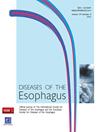444. t2食管鳞状细胞癌是否应该根据淋巴结累及和生存率进行亚分类?
IF 2.3
3区 医学
Q3 GASTROENTEROLOGY & HEPATOLOGY
引用次数: 0
摘要
T2食管鳞状细胞癌是否应分为环肌(T2a)和纵肌(T2b)仍有争议。我们旨在研究固有肌层浸润深度对T2食管鳞状细胞癌淋巴结转移发生率和患者生存结果的影响。我们确定了2009年1月至2017年6月接受一期手术的pT2食管鳞状细胞癌患者。对固有肌层侵犯深度的病理信息进行重新评估,并将患者分为T2a组和T2b组。二元逻辑回归用于确定淋巴结转移的危险因素。使用Kaplan–Meier分析和Cox比例风险回归模型研究了固有肌层侵犯深度对生存率的影响。这项研究共包括来自三个研究所的750名患者。固有肌层侵犯深度(OR:3.95,95%CI:2.46–6.35;P < 0.001)与淋巴结转移相关。T亚阶段(OR:1.37,95%CI:1.05–1.79;P < 0.001)和N状态(OR:1.51,95%CI:1.05–2.17;P < 0.001)是多变量Cox回归分析中的独立危险因素。T2a组的总生存率较好(OR:1.52,95%CI:1.19-1.94;P = 0.001),特别是在T2N0患者中(OR:1.38,95%CI:1.08-1.94;P = 0.035)。就T2食管鳞状细胞癌的淋巴结受累和生存结果而言,固有肌层侵犯的深度应分为T2a和T2b。本文章由计算机程序翻译,如有差异,请以英文原文为准。
444. SHOULD T2 ESOPHAGEAL SQUAMOUS CELL CARCINOMA BE SUBCLASSIFIED WITH RESPECT TO LYMPH NODE INVOLVEMENT AND SURVIVAL?
Whether T2 esophageal squamous cell carcinoma should be subclassified into circular muscle (T2a) and longitudinal muscle (T2b) remains controversial. We aimed to investigate the effect of the depth of muscularis propria invasion on the incidence of lymph node involvement and patient survival outcomes in T2 esophageal squamous cell carcinoma.
We identified patients with pT2 esophageal squamous cell carcinoma who underwent primary surgery from January 2009 to June 2017. The pathological information of the depth of muscularis propria invasion was reassessed, and patients were grouped into the T2a group and T2b group. Binary logistic regression was used to determine risk factors for lymph node metastases. The impact of the depth of muscularis propria invasion on survival was investigated using Kaplan–Meier analysis and a Cox proportional hazard regression model.
This study included a total of 750 patients from three institutes. The depth of muscularis propria invasion (OR: 3.95, 95% CI: 2.46–6.35; P < 0.001) was correlated with lymph node metastases using logistic regression. T substage (OR: 1.37, 95% CI: 1.05–1.79; P < 0.001) and N status (OR: 1.51, 95% CI: 1.05–2.17; P < 0.001) were independent risk factors in multivariate Cox regression analysis. The T2a group had better overall survival (OR: 1.52, 95% CI: 1.19–1.94; P = 0.001) than the T2b group, specifically in T2N0 patients (OR: 1.38, 95% CI: 1.08–1.94; P = 0.035).
The depth of muscularis propria invasion should be subclassified to T2a and T2b with respect to lymph node involvement and survival outcomes in T2 esophageal squamous cell carcinoma.
求助全文
通过发布文献求助,成功后即可免费获取论文全文。
去求助
来源期刊

Diseases of the Esophagus
医学-胃肠肝病学
CiteScore
5.30
自引率
7.70%
发文量
568
审稿时长
6 months
期刊介绍:
Diseases of the Esophagus covers all aspects of the esophagus - etiology, investigation and diagnosis, and both medical and surgical treatment.
 求助内容:
求助内容: 应助结果提醒方式:
应助结果提醒方式:


